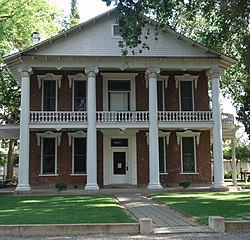
Victorian architecture is a series of architectural revival styles in the mid-to-late 19th century. Victorian refers to the reign of Queen Victoria (1837–1901), called the Victorian era, during which period the styles known as Victorian were used in construction. However, many elements of what is typically termed "Victorian" architecture did not become popular until later in Victoria's reign, roughly from 1850 and later. The styles often included interpretations and eclectic revivals of historic styles (see Historicism). The name represents the British and French custom of naming architectural styles for a reigning monarch. Within this naming and classification scheme, it followed Georgian architecture and later Regency architecture and was succeeded by Edwardian architecture.

The Italianate style was a distinct 19th-century phase in the history of Classical architecture. Like Palladianism and Neoclassicism, the Italianate style combined its inspiration from the models and architectural vocabulary of 16th-century Italian Renaissance architecture with picturesque aesthetics. The resulting style of architecture was essentially of its own time. "The backward look transforms its object," Siegfried Giedion wrote of historicist architectural styles; "every spectator at every period—at every moment, indeed—inevitably transforms the past according to his own nature."
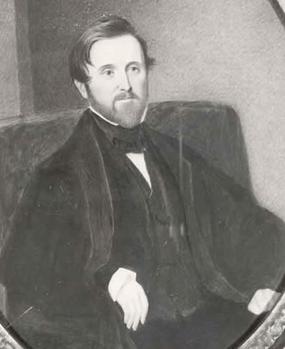
Alexander Jackson Davis was an American architect known particularly for his association with the Gothic Revival style.
A plantation house is the main house of a plantation, often a substantial farmhouse, which often serves as a symbol for the plantation as a whole. Plantation houses in the Southern United States and in other areas are known as quite grand and expensive architectural works today, though most were more utilitarian, working farmhouses.

The Sycamore Historic District is a meandering area encompassing 99 acres (400,000 m2) of the land in and around the downtown of the DeKalb County, Illinois county seat, Sycamore. The area includes historic buildings and a number of historical and Victorian homes. Some significant structures are among those located within the Historic District including the DeKalb County Courthouse and the Sycamore Public Library. The district has been listed on the National Register of Historic Places since May 2, 1978.

The Oregon Commercial Historic District is a historic district in Oregon, Illinois, that has been listed on the National Register of Historic Places since 2006. The district is roughly bordered by Jefferson, Franklin, 5th and 3rd Streets in Oregon. It is one of six Oregon sites listed on the National Register and one of three to be so listed since the turn of the 21st century. The other two are the Oregon Public Library, listed in 2003, and the Chana School, listed in 2005.

The Smith-McDowell House is a c. 1840 brick mansion located in Asheville, North Carolina. It is one of the "finest antebellum buildings in Western North Carolina." Listed on the National Register of Historic Places, it was the first mansion built in Asheville and is the oldest surviving brick structure in Buncombe County. Since October, 2023, the building is home to Asheville Museum of History.
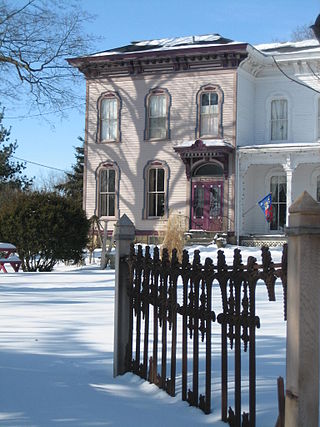
The houses in the Sycamore Historic District, in Sycamore, Illinois, United States, cross a variety of architectural styles and span from the 1830s to the early 20th century. There are 187 contributing properties within the historic district, 75% of the districts buildings. Many of the homes are associated with early Sycamore residents, usually prominent business leaders or politicians. Houses within the district are known by, either their street address or by a name associated with a prominent owner or builder. For most of the houses, the latter is true.

Montgomery Place, now Bard College: The Montgomery Place Campus, near Barrytown, New York, United States, is an early 19th-century estate that has been designated a National Historic Landmark. It is also a contributing property to the Hudson River Historic District, itself a National Historic Landmark. It is a Federal-style house, with expansion designed by architect Alexander Jackson Davis. It reflects the tastes of a younger, post-Revolutionary generation of wealthy landowners in the Livingston family who were beginning to be influenced by French trends in home design, moving beyond the strictly English models exemplified by Clermont Manor a short distance up the Hudson River. It is the only Hudson Valley estate house from this era that survives intact, and Davis's only surviving neoclassical country house.

The Clayton-Cedarmere Estates are located in Roslyn Harbor, New York, United States, listed jointly on the National Register of Historic Places in 1986. Clayton, the bulk of the property, is the large landscaped Bryce/Frick estate, now home to the Nassau County Museum of Art. Cedarmere, the smaller of the two, is William Cullen Bryant's estate, currently undergoing interior renovation, is located on the west side of Bryant Avenue; overlooking Hempstead Harbor, now a historic house museum. The grounds are open to the public. The two combined properties, with input from several notable architects, illustrate the development of estates on the North Shore of Long Island over a period of nearly a century.
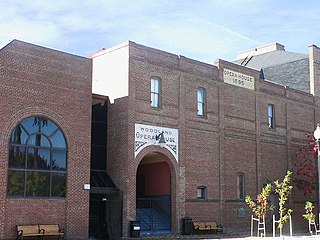
The Woodland Opera House, listed on the National Register of Historic Places and a California Historical Landmark, is one of four fully functioning 19th century opera houses in California. It is a contributing property to the Downtown Historic District of Woodland, California.

The Gable Mansion is a Victorian mansion in Woodland, California, listed as a California Historical Landmark, that was built in 1885 for Amos and Harvey Gable, two Yolo County pioneers and ranchers.

The Yolo County Courthouse was a courthouse for the Superior Court of California in Yolo County in Woodland, California until 2015. The original building was erected in 1864, and was used for 37 years until condemned in 1911. The edifice, built in the same location in 1917, was listed on the National Register of Historic Places in 1987, and is also a contributing property in the Downtown Woodland Historic District.
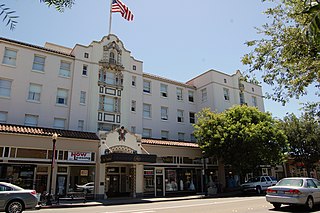
Hotel Woodland is a historic hotel located in Woodland, California and designed by William Henry Weeks. The hotel is on the National Register of Historic Places, and is a contributing property of the Downtown Woodland Historic District.

The Griffith Mansion is a historic residence which remains a private family home on 14 acres (5.7 ha) in Yolo, California, built by Abram Griffith in 1886.

The Fyler–Hotchkiss Estate, also known as the Hotchkiss-Fyler House Museum, is a historic house museum at 192 Main Street in Torrington, Connecticut. Operated by the Torrington Historical Society, its main house is a well-preserved and distinctive example of Chateauesque Victorian architecture. It is also significant for its association with Orsamus Fyler, a prominent local politician and businessman. The property was listed on the National Register of Historic Places in 2009.

Valparaiso has retained an active downtown. It remains a mix of government, retail and business center, with a mixed residential and service area. Numerous economic changes have not changed the basic character, historic courthouse area. The historic district retains the distinctive turn-of-the-19th-century architecture, supporting numerous small specialty shops, shaded sidewalks, and a people friendly environment. The Downtown District, is anchored on the Porter County Courthouse. It includes 14-blocks surrounding the square, bounded on the north by Jefferson Street, on the east by Morgan Street, on the south by Monroe Street, and on the west by Napoleon Street.

Shirenewton Hall, originally Shirenewton Court, is a country house and estate adjoining the village of Shirenewton, Monmouthshire, Wales, about 3 miles (4.8 km) west of Chepstow. The 29.5-acre (11.9 ha) estate is located on a hillside, and commands views across the "Golden Valley" to the west and the Severn Estuary in the south. The main building was constructed around 1830, and partly rebuilt around 1900–1910, on the site of an earlier house which was the birthplace of William Blethyn, Bishop of Llandaff. The house is now a Grade II listed building, and the teahouse in the adjoining Japanese garden is listed as Grade II*. The gardens are included on the Cadw/ICOMOS Register of Parks and Gardens of Special Historic Interest in Wales. The estate is not open to the public.

d'Estaville, also spelled D'Estaville, is a large bluestone Italianate-style heritage-listed house located at 7 Barry Street in the Melbourne suburb of Kew, Victoria, Australia. Designed by architects Knight & Kerr for politician and long term Chief Justice of Victoria, Sir William Foster Stawell, d’Estaville was completed in 1859. d’Estaville is a fine and unusual example of the Italianate style, and the only residential work of Knight & Kerr, designers of the Victorian Parliament House.

The Richard Pousette-Dart House and Studio is a historic property located northeast of Suffern in Rockland County, New York. The American Craftsman and Bungalow-style, stone building was originally erected c. 1916 as a carriage house for a country estate owned by New York City merchant Henry Potter McKenny. From 1959 to 1992, the structure served as the family home and studio of Richard Pousette-Dart (1916–1992), an American abstract expressionist artist and founding member of the New York School of painting. In 2019, the house was added to the National Register of Historic Places.
